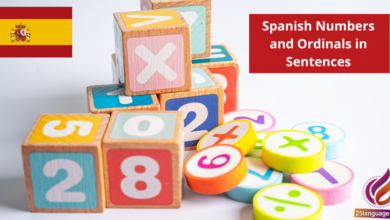Spanish Demonstrative Pronouns

Have you ever pointed to something in a conversation and wished you could do the same in Spanish? understanding demonstrative pronouns is key! In today’s lesson, we’ll explore how to use “este,” “ese,” and “aquel” to express proximity and distance in a way that brings your Spanish conversations to life. Mastering these words will not only enhance your communication skills but also deepen your understanding of the stunning nuances of the Spanish language. Let’s dive in!
Understanding Spanish Demonstrative Pronouns for Clear Communication
Demonstrative pronouns in Spanish indicate specific items or people in relation to the proximity of the speaker. They are categorized based on whether the noun they refer to is close, at a moderate distance, or far away. The three primary demonstrative pronouns in Spanish are:
- este / esta (this – masculine/feminine): Used for items that are close to the speaker.
- ese / esa (that – masculine/feminine): Used for items at a moderate distance from the speaker.
- aquél / aquélla (that – masculine/feminine, more distant): Used for items that are far from the speaker.
Such as:
- Este libro es muy interesante. (This book is very interesting.)
- Ese coche es nuevo. (That car is new.)
- Aquella casa es antigua. (That house is old.)
Additionally, the pronouns agree in gender and number with the nouns they replace.Here’s a simple table summarizing the variations:
<td/aquellos
| Spanish Pronoun | Gender | Number | English Translation |
|---|---|---|---|
| este | masculine | singular | this |
| esta | feminine | singular | this |
| estos | masculine | plural | these |
| estas | feminine | plural | these |
| ese | masculine | singular | that |
| esa | feminine | singular | that |
| esos | masculine | plural | those |
| esas | feminine | plural | those |
| aquel | masculine | singular | that (far) |
| aquélla | feminine | singular | that (far) |
| masculine | plural | those (far) | |
| aquéllas | feminine | plural | those (far) |
Navigating Este, Ese, and Aquel: A practical Guide
In Spanish, the words este, ese, and aquel are demonstrative adjectives used to indicate the proximity of nouns. They can be roughly translated to “this,” “that,” and “that over there,” respectively. Understanding how to use these words is crucial for effective communication, as they help specify which object you are talking about based on it’s distance from the speaker. Here are the key points to remember:
- Este – refers to a noun that is close to the speaker.
- Ese – refers to a noun that is further away, but still relatively close.
- Aquel – refers to a noun that is far from both the speaker and the listener.
For example, if you are holding a book, you can say “Este libro es interesante” (This book is interesting). if the book is on a table nearby, you’d say “Ese libro sobre la mesa es interesante” (That book on the table is interesting). Lastly, if a book is across the room, you could refer to it as “Aquel libro en la esquina es interesante” (That book in the corner is interesting). Below is a simple table summarizing these concepts:
| Spanish Example | Translation | Demonstrative Used |
|---|---|---|
| Este coche es rápido. | This car is fast. | Este |
| Ese perro es amable. | That dog is amiable. | Ese |
| Aquel edificio es antiguo. | That building over there is old. | aquel |
Mastering Spanish Demonstrative Pronouns with Examples and Tips
in Spanish, demonstrative pronouns are used to indicate specific things or people and are crucial for clear communication. There are three main sets of demonstrative pronouns: este/esta (this), ese/esa (that), and aquello/aquella (that over there). Each pronoun changes form depending on the gender and number of the noun it refers to. As a notable example, este refers to a masculine singular noun, while esta refers to a feminine singular noun. If speaking about plural items, estos (masculine) and estas (feminine) are used. Here are some examples to illustrate their use:
- Este libro es interesante. (This book is interesting.)
- Esta casa es bonita. (This house is pretty.)
- Esos coches son rápidos. (Those cars are fast.)
- Esas flores son hermosas. (Those flowers are beautiful.)
- Aquellos árboles son altos. (Those trees over there are tall.)
- Aquellas montañas son impresionantes. (Those mountains over there are impressive.)
| Spanish Example | english Translation | pronoun Used |
|---|---|---|
| Este coche | This car | Este |
| Esas sillas | Those chairs | Esas |
| Aquel perro | That dog over there | Aquel |
| Estas frutas | These fruits | Estas |
| Ese libro | That book | Ese |
Context is key when choosing the appropriate pronoun. Este and esta are used to refer to things that are close to the speaker, while ese and esa are used for items that are further away but still within reach. Aquel and its variations are reserved for items that are much further away or even out of sight. Remembering these spatial references will greatly enhance your fluency when using demonstrative pronouns. Consider the following: when you point to a nearby object,say,Este teléfono (This phone),but for an object just out of reach,like a book on the shelf,you would use Ese libro (That book).
Connecting ideas with Este, Ese, Aquel: A Comprehensive Approach
In Spanish, the demonstrative pronouns ‘este’, ‘ese’, and ‘aquel’ are essential for indicating specific nouns based on their proximity to the speaker. ‘Este’ refers to something nearby, ‘ese’ to something at a medium distance, and ‘aquel’ to something far away. The gender and number of the noun being referenced affect the form of the demonstrative pronoun. For example:
- Este libro (this book) – singular, masculine
- Esta mesa (this table) – singular, feminine
- estos zapatos (these shoes) – plural, masculine
- Estas sillas (these chairs) – plural, feminine
Similarly, ‘ese’ and ‘aquel’ function in the same manner:
- Esa casa (that house) – singular, feminine
- Aquel coche (that car over there) – singular, masculine
- Esos libros (those books) – plural, masculine
- Aquellas casas (those houses over there) – plural, feminine
| Spanish Example | English Translation | Rule |
|---|---|---|
| Este perro | This dog | Proximity: Near |
| Ese gato | That cat | Proximity: medium distance |
| Aquel árbol | That tree over there | Proximity: Far away |
To Wrap It Up
Conclusión de la lección sobre Pronombres Demostrativos en Español: Este, Ese, Aquel…
¡Felicitaciones por llegar al final de nuestra lección sobre los pronombres demostrativos en español! Hoy hemos explorado la importancia de “este,” “ese,” y “aquel,” herramientas clave que nos ayudan a señalar y describir cosas y personas en nuestro entorno. Recuerden que “este” se utiliza para lo que está cerca, “ese” para lo que está a una distancia media y “aquel” para lo que está más lejos.
Estos pronombres son esenciales no solo para la gramática, sino también para la comunicación efectiva. A medida que continúen su aprendizaje del español,les animo a que los practiquen en su vida diaria. Piensen en los objetos a su alrededor y traten de describirlos usando los pronombres que hemos aprendido.
No duden en compartir sus progresos y experiencias. Cada pequeño paso que dan en su aprendizaje es un gran avance hacia la fluidez. Recuerden que la práctica hace al maestro, y cuanto más utilicen lo aprendido, más natural se volverá.
¡Sigan adelante! El mundo del español está lleno de oportunidades, y ustedes están en el camino correcto. ¡Hasta la próxima lección!





























